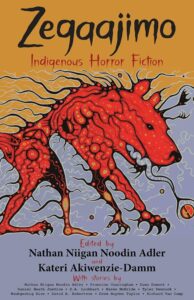Book review: Zegaajimo: Indigenous Horror Fiction
 Reviewed by Caroline MacKenzie
Reviewed by Caroline MacKenzie
Zegaajimo: Indigenous Horror Fiction edited by Nathan Niigan Noodin Adler and Kateri Akiwenzie-Damm is a collection of short stories by various Indigenous authors. Zegaajimo is Anishinaabemowin/Ojibwe meaning “to tell a scary story.” These spine-chilling stories all pass on teaching from the Anishinaabe culture, and they all take place in modern times but involve teachings that have been passed down through the generations. This is a collection of stories that is more suited to older teens and adults.
The tone of these stories is dark and mysterious. The reader is never sure what to expect from these exciting and chilling stories, keeping them interested and reading. This allows the reader time to process and absorb the teachings within the stories and increases their knowledge of Indigenous teachings and cultures.
Although these stories are written by different authors, together, they form an intriguing collection of tales. The tone and subject matter are similar enough that there is a flow and connection between them. This keeps the reader in the moment and focused on the teachings. However, they are also unique, ensuring that the reader gets different experiences and teachings from each one. Furthermore, the authors have different life experiences, which influence their story-telling. This increases the chances that the reader will find something that they can relate to.
The teachings in this collection of stories are written in such a way that both Indigenous and non-Indigenous people can relate to and learn from them. The language used by the writers is familiar and universal. This allows for the reader to engage in a deeper, more meaningful understanding of the teachings within these stories.
The fact that these stories are accessible to non-Indigenous people, serves to educate them about Indigenous cultures and the teachings that are part of them. Non-Indigenous people can find things within the story they can relate to, therefore forming a deep connection with the story and the teachings within. This can serve as a path to reconciliation and interest in other cultures or perspectives.
These stories combine traditional Indigenous teachings with non-traditional experiences and situations. This gives both Indigenous and non-Indigenous people something they can related to. This encourages readers from different backgrounds to access the teachings within each of the stories and learn from them.
These stories also empower Indigenous readers to connect or reconnect with their culture. They may discover teachings they have not heard before or are presented in a new way. Furthermore, this introduces these traditional teachings to non-Indigenous readers. They therefore learn more about Indigenous culture; knowledge that can help foster respect for Indigenous culture and hopefully by extension, other cultures and ideas.
Another factor that increases the accessibility of this collection is the characters. They have aspects of their personalities that the reader can identify with. This makes the teachings more personal and relevant to the reader allowing them to process the teachings. Again, this can further the reader’s understanding of Indigenous culture and show a path towards reconciliation.
The pace of these stories keeps the reader engaged and reading. This opens the reader up to different points of view and cultures. As a result, the reader’s interest in and respect for Indigenous cultures and by extension other cultures, grows. This collection is an amazing tool for those who want to learn about Indigenous culture and teachings, and forge a path to reconciliation.
Various Indigenous contributors, edited by Nathan Niigan Noodin Adler and Kateri Akiwenzie-Damm, Zegaajimo: Indigenous Horror Fiction. Kegedonce Press: Chippewas of Nawash First Nation, 2024.
ISBN: 9781928120445

